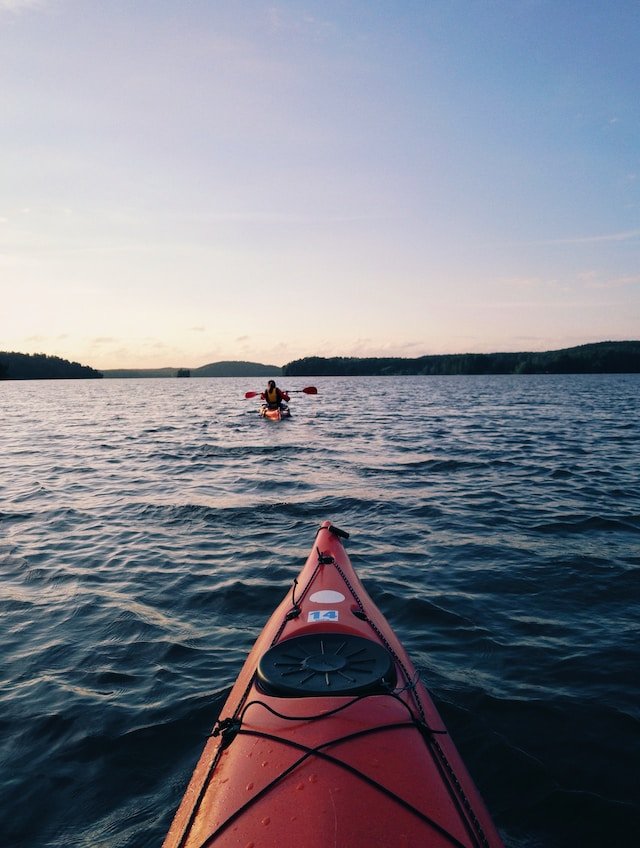How Hard Is Kayaking?

Kayaking is a popular sport. As summer annually draws nigh, you see kayakers all over the world getting ready for a relaxing time on the water to enjoy what they love. You might also be considering joining them and thus wonder; how hard is kayaking?
Is it worth giving time to? Can I even master it? Worry no more and read through as we put your mind at ease on this somewhat controversial topic.
What Is Kayaking?
Kayaking is a popular water sport that can be enjoyed by people of all ages, regardless of their fitness level or experience.
It is a great way to get exercise and spend time with friends or family. Kayakers use a variety of different strokes to move through the water, including rolling, gliding, and paddling.
Kayaking can be both challenging and exhilarating. It can also be a great way to see scenic areas that would otherwise be inaccessible and enjoy nature.
What Is A Kayak?
Kayaks are a unique type of vessel that is often used for recreation or as a mode of transportation.
They are typically made of plastic, wood, or aluminum, and can be paddled with one or two hands. Kayaks come in a variety of shapes and sizes and can be used for both freshwater and saltwater activities.
They are typically easy to store and transport, making them an ideal option for those who want to enjoy the outdoors without having to worry about cumbersome gear. Nowadays, inflatable kayaks make it possible to carry even less gear when enjoying the great outdoors.
Inflatable Kayaks
Even better than traditional kayaks are inflatable kayaks. They offer a unique experience that is not available with traditional kayaks; they are more comfortable than traditional kayaks, can be stored more easily, and are cheaper to operate.
Inflatable kayaks are easy to store and transport, making them a popular choice for travelers. Inflatable kayaks are also versatile, being capable of being used for both recreational and fishing purposes.
There are a few considerations you should take into account before purchasing an inflatable kayak, including the weight capacity, size, inflation time, durability, and rower compatibility.
What Does Kayaking Entail?
Kayaking entails using a kayak as an essential mode of transportation on the water. It involves getting on a kayak, sitting in the middle, and paddling with paddles.
Kayakers can use their kayaks for many things, such as fishing, swimming, exploring rivers and lakes, or just having some fun. Kayakers use a variety of techniques to move through the water.
Paddling is the most common technique, but some kayakers also use powerboats and canoes.
Requirements For Kayaking
Kayaking can be enjoyed by anyone of any age with the proper equipment and instruction. However, there are some basic requirements that everyone should know before getting into kayaking to be safe and have a great experience.
- First and foremost, you need to be properly fitted for your kayak. Kayaks come in a variety of sizes and shapes, so it is important to choose the right one for your body type, weight, and height.
- Learn the basics of kayaking. You can surf the net, watch videos, and even take an experienced kayaker with you until you are sure you can handle yourself properly on the water.
- Always check your equipment and ensure it is in excellent condition before hitting the water. Kayaking with faulty equipment is asking for trouble.
- You should be in good physical condition, know how to swim, and have a dry suit or jacket if you plan on going out into the open ocean. These are important as they will keep you safe should an emergency occur.
- Kayakers also need to be aware of weather conditions, as the open water can be dangerous in bad weather.
- Be safety conscious and keep an eye out for hazards in the water.
- Obey all local safety regulations.
Is Kayaking Hard?
Kayaking is a popular sport and activity for people of all ages. It’s easy to learn, and there are many different types of kayaks to choose from.
Kayakers can expect a challenging workout, but it’s not as hard as you might think. Listed below are four reasons why kayaking isn’t as hard as it looks:
- Kayaks are light and easy to maneuver.
- They have tracking systems that keep you on course even in choppy water.
- You don’t have to paddle as hard as you do when fishing or swimming.
- Kayaks are very stable in rough water, so you don’t have to worry about capsizing or tipping over.
While kayaking is relatively easy, it does have some level of difficulty. It, however, comes down to the individual. Some people take to kayaking right away, while others may need time to adjust to this glorious sport.
Either way, be sure to enjoy your time in a kayak on the water. Like most things, kayaking has both a physical and a mental aspect.
The Physical Aspect of Kayaking
Kayaking is a great way to get some exercise, see the natural beauty of the waterways, and make new friends. However, not all kayakers are created equal. You need to be physically fit to kayak. Here are five tips for staying in good shape while kayaking:
- Stay hydrated by drinking plenty of water throughout the day.
- Avoid overworking your muscles by using good form when kayaking.
- Carry a small towel in the kayak so you can dry off when you get out of the water.
- Don’t push yourself too hard. Take breaks when you have to; if you start feeling weak, take leave from the water for a while.
- Don’t worry about how much exercise your body is getting. It’s not like running or lifting weights; kayaking is relaxing, and it provides a good workout.
It’s important to keep in mind that while kayaking s fun, you will have to paddle and employ other techniques requiring physical strength. In that respect, kayaking is very much a physical activity involving the use of muscles in the arms, back, and legs.
Naturally, constant use of those muscles helps burn fat and stay in shape. Kayaking also increases alertness as constant awareness of your surroundings is crucial for safe kayaking. To kayak smoothly, proper form is essential.
Kayakers need to keep their upper body parallel to the water surface and their lower body slightly angled towards the center of the kayak. They should also keep their heads up and eyes looking forward so they can see where they are going.
All in all, kayaking is a great source of exercise; it’s an obvious physical activity, but it can also be a mental one.
The Mental Aspect of Kayaking
Kayaking can be a great way to get exercise and enjoy the outdoors, but it’s not just about getting from point A to point B; kayaking can be a very mentally challenging activity as well.
Kayakers need to have a strong mental game to enjoy the sport, as there is a lot of concentration required. Here are some tips for improving your mental game and helping to make kayaking a more mentally rewarding experience:
- Find a good kayaking guidebook or online forum to follow. This will give you specific instructions on how to navigate the waterways and avoid dangerous areas.
- Try to plan to kayak in the same area more than once during your trip. This will give you a better idea of where you’re going and what to expect.
- Bring along a few items with which you can help yourself if a difficult situation arises. This could be a small first aid kit, or a pair of gloves to help with paddling.
- Be prepared before you paddle out. Make sure you have everything you need, including water, sunscreen, snacks, a map, and sunglasses.
- Make sure you’re wearing a life jacket.
- Bring along a few items that can help if your kayak capsizes, such as a whistle, signal mirror, and flag.
- Respect the rules of the waterway you’re kayaking in.
- Pay attention to the environment around you. Paying attention to the trees, water, and other kayakers can help you avoid collisions.
- Don’t go out too fast, especially if you have a beginner or less experienced kayaker with you.
Kayaking is indeed a mentally taxing activity, but that doesn’t negate the fact that it is fun. Kayaking is a great way to de-stress.
While kayaking, you can abandon mundane concerns, ensure you are safe, and be laid back for the duration of your adventure. Kayaking is also a great way to deepen your bonds with those close to you.
Spending time with your loved ones on the water will bring you closer, enabling your interpersonal relationships to blossom without souring. Kayaking, like many sports, is the ideal middle ground.
While kayaking, you meet different people on the water, which is a good way to build more relationships and live a peaceful and fulfilled life. For all its hardships, kayaking is undoubtedly a fun and rewarding sport.
Tips For Beginners
Kayaking can be a great way to enjoy nature while getting a workout. There are a few things you need to know before starting, though. Here are some tips for getting started:
- Make sure you have the right equipment. Kayaks come in different shapes and sizes, so make sure you pick the one that is comfortable for you. You’ll also need paddles and a life jacket. Make sure that you have all the supplies you need and know how to use them.
- Learn the basics of kayaking before you go out. This includes learning how to paddle, how to use your boat’s features, and where to find help if you get into trouble. Try to find a quiet area that is not too far from your home. This will make it easier for you to get in and out of the water without causing any problems for you or others.
- Make sure that you’re wearing sunscreen and protective clothing before leaving your home. You don’t want to get sunburned while you are out practicing your skills.
- If the water is cold, bring a hat and gloves.
- If the water is warm, wear shorts and a T-shirt instead of pants and a shirt.
- Practice paddling and maneuvering the kayak by moving it in your yard or driveway for a couple of hours before venturing out on the water.
- Know your surroundings. Knowing the waterway where you kayak ensures you don’t get lost and can easily get help if needed.
- Don’t try to go faster than you can handle. Give yourself a break and take it easy on your first trip out.
- Stay within eyesight of the shore and keep other boats in sight at all times.
- Obey all safety boating rules in your area and ensure you meet the local requirements to kayak in any waterway.
- Don’t take unnecessary risks and go with an experienced kayaker till you’ve mastered the sport.
- Always check the weather forecast to ensure you have favorable weather before kayaking. Stop kayaking if you notice the weather turning hostile. Kayaking in foul weather is extremely dangerous.
- Stay hydrated and safe on the water.
Best Kayaks For Beginners
Kayaking is a fun sport and like all sports, the equipment used plays a great role in how safe and enjoyable the sport will be.
If you are new to kayaking, there are a few different types of kayaks that you should consider. A beginner-friendly kayak will be stable, comfortable, and easy to paddle.
Depending on your experience level, the type of kayak you choose may change. Here are five kayaks that are perfect for beginners:
- Wilderness Systems Pungo 120
- Lifetime Tamarack Pro 103
- Perception Drift 9.5
- Old Town Dirigo 106
- Trailblazer 100 NXT
Kayaking can be a fun and rewarding experience for people of all ages and abilities when done correctly. However, it is important to remember that kayaking can be a strenuous activity, and it is not recommended for people who are not in good physical condition, it is a form of exercise, after all.
If you are interested in kayaking, it is important to do your research and find a reputable kayak school or instructor to help you get started. It is important to be aware of the risks and take proper precautions before heading out on the water.
With a little patience and practice, kayaking can be easy to learn and is a great way to get outdoors and enjoy nature. So what are you waiting for? Get out on the water today and have fun!
Frequently Asked Questions
Is it hard to sit in a kayak?
It’s not easy to sit in a kayak, but it’s worth it. Kayaking is one of the most peaceful and exhilarating ways to get around. You can explore beautiful waterways without any disturbance, and you can get up close and personal with nature. Here are three tips for sitting in a kayak for an extended period:
- Make sure your kayak is well-fitted for your body size and weight. A poorly fitted kayak will cause you pain and fatigue.
- Get a kayak that’s easy to paddle. You will get tired if you have to push yourself as hard as possible just to stay in the boat.
- Make sure there are no sharp edges on the inside of your kayak. The minute you start to feel uncomfortable, sit up and move around a little. If you spend longer than 30 minutes in one position, get out.
Is it easy to capsize in a kayak?
Kayaks are inherently stable, even in rough waters, and have little chance of capsizing. They are some of the safest watercraft. However, though rare, capsizing can happen quickly and without warning in even the simplest kayaks; you can never be too careful.
Even with proper training, it is important to be aware of potential dangers when kayaking and know how to respond if something goes wrong. The safest preventive measures against capsizing are:
- Always wear a life jacket when kayaking. Even if you think you won’t need it, it can provide some extra protection in case of an emergency.
- Keep a close eye on the weather conditions. Do not kayak in dangerous weather.
- Do not kayak in rough water.
- Have a means of quickly calling for aid should your vessel capsize.
Is kayaking more difficult than canoeing?
Kayaking is often thought of as being more difficult than canoeing, but this is not always the case. In actuality, most beginners find kayaking easier to learn than canoeing. Both sports, however, require training, patience, and practice.
Canoes are narrower in the beam than kayaks, making them easier to control in confined areas. Kayaks have a similar width at the beam, but are wider in the body and therefore more stable.
Kayakers also have longer boats than canoeists, giving them more stability when navigating through tight channels or around rocks. Despite the differences in the equipment of each sport, they are both fun.






